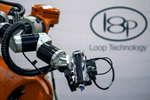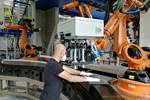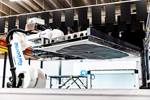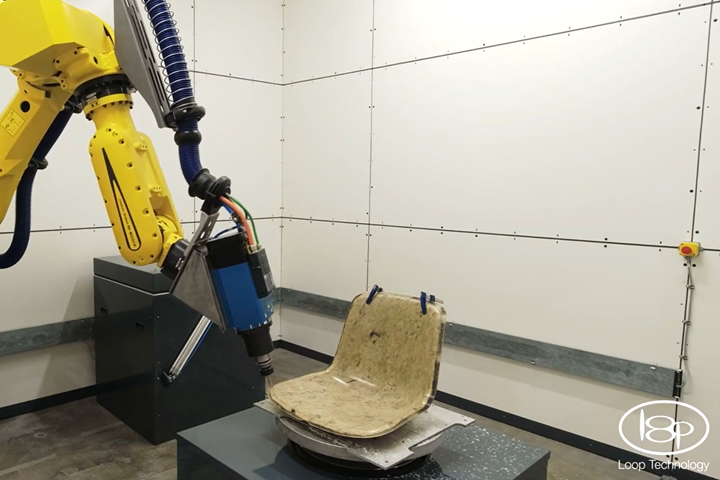Loop Technology performs robotic feasibility study for Solidwool
The study revealed significant process efficiencies, reduced waste and a high-quality surface finish after trimming excess material from a Solidwool composite chair.
Robotic programming with Solidwool chair. Photo Credit, all images: Loop Technology Youtube video
Loop Technology (Dorchester, U.K.) announced in a recent case study that it performed a feasibility study using its RoboMACH HA cell, a high-accuracy robotic machining system for complex, large-volume applications, to support Solidwool’s (Devon, U.K.) investigation into technologies that would improve the manufacturing process efficiency and sustainability of its furniture, interior design finishes and homeware products, which are made from wool fibers reinforced with bio-resin.
A process of particular interest was trimming the excess bio-resin from the edges of Solidwool’s chairs after the molding process. This excess material is a common and necessary feature when making many types of composite components. Trimming is typically done by hand using a disc cutter or with a CNC machine. Nevertheless it is time-consuming and highly various when manually performed. Solidwool also considered trimming with a CNC machine, though while it can produce a repeatable, high-quality finish, their costs can be inhibitive and have limited flexibility compared to a multiaxis robotic solution.
Loop Technology suggested RoboMACH HA. The robot programs to trim the chair were generated using Robotmaster (Hanover, N.H., U.S.), an offline programming and robot simulation software. It is said to minimize robotic programming time from hours to minutes by generating robot control code directly from CAD/CAM tools. The following steps were taken:
- A CAD model of the chair was imported into the virtual RoboMACH HA cell, created in Robotmaster. Features such as fixtures were programmed to ensure they were avoided by the robot.
- The cutting paths were created. This was done by selecting the edges of the chair. As trimming would need to be done in two parts using the rotary table, two paths were created.
- A simulation was run to visualize the process and apply any adjustments to the cutting paths that had been generated, such as a toolpath offset and Z-position.
- The cutting paths were translated into robot paths by Robotmaster. Problems such as limits reached or collisions were flagged up by the software, and the paths were modified directly in the software.
- The robot paths were assigned to a post-processer to handle the supporting functions such as the spindle rpm.
- The generated robot code was transferred to Loop Technology’s FANUC (Huntersville, N.C., U.S.) M800iA/60 robot.
Multiple passes were used in this feasibility study to assess the chair after each pass.
The robot achieved a high-quality, smooth finish. The results showed that robotic machining would reduce the amount of time and handling required to trim a chair, leading to shorter lead times and significant cost savings. It also showed the high accuracy and repeatability of the robot would prevent parts from being machined incorrectly, leading to reduced process waste.
This feasibility study has helped Solidwool understand the capabilities of robotic machining, and how it could fit into its manufacturing process. The knowledge gained will assist the company in planning future expansion.
Related Content
-
Airborne delivers composite upper stage tank for EU ENVOL project
Nine-member consortium targets development of low-cost, green vertical orbital launcher with manufacture of an ultra-lightweight composite tank design in an automated manufacturing environment.
-
Optimizing robotic winding of composite tanks and pipes
Pioneer in mandrel-based reinforced rubber and composite products, TANIQ offers TaniqWindPro software and robotic winding expertise for composite pressure vessels and more.
-
Manufacturing the MFFD thermoplastic composite fuselage
Demonstrator’s upper, lower shells and assembly prove materials and new processes for lighter, cheaper and more sustainable high-rate future aircraft.

















